Identifying the Lack of Energy-Conscious Behaviour in Clinical and Non-Clinical Settings: An NHS Case Study
Abstract
:1. Introduction
Research Contribution and Impact
- A novel methodology is proposed, in order to identify where energy is wasted by analysing the electricity consumption of two independent clinical and non-clinical areas in MWNFT. This involves the analysis of electricity consumption patterns, in light of occupancy and the consideration of the member’s of staff mindset and behaviour towards energy usage, through a questionnaire and an equipment audit to pinpoint which equipment is left switched on unnecessarily.Significance and Impact: This contribution is believed to be a game changer, when it comes to energy management. Studies, such as [5,22,23,24], that focus on the high energy consumption problem tend to overlook the “Why?” question and focus on bringing down the numbers by introducing energy-saving measures. However, there are far simpler and cheaper methods to bring down energy, carbon emissions, and costs. The Department for Energy and Climate Change (DECC) have published several energy efficiency guidelines for the community to follow. In [25], the DEEC were providing guidelines to small and medium-sized enterprises (SMEs), in relation to energy efficiency. The main focus of the report was to point out basic and cheap measures to reduce wasted energy, in order to cut down energy costs. Several case studies were reported, including that of the Chinese Contemporary Arts Centre in Manchester, which managed to save 4363 pounds and tonnes of CO a year by installing a 100 pounds timer, after discovering heaters were left switched when the occupancy of the rooms was zero. Thereby, successfully pinpointing where and how energy is wasted would enable energy management personnel to focus their efforts in one place and ensure the maximum effectiveness of the implemented energy conservation techniques.
- To the best of the authors’ knowledge, this study is the first of its kind to address the issue of energy usage behaviour in a hospital environment.Significance and Impact: Although the analysis and methodology presented are applicable to data collected in any environment, this research study invites the question “Why hospitals and not any other type of building?". The answer to this question lies in the fact that hospitals are high consumers of energy when compared to other types of buildings [26]. A study reported that the healthcare sector spends 400 pounds million per year on energy [27], while another reported 750 million pounds [28]. The 24-h operation of hospitals throughout the year makes it the biggest consumer but also creates the high potential to save energy in a society [29]. Thereby, it is hoped that by following the footsteps of this paper, other studies will emerge that tackle the same issue in other hospitals with the sole purpose of making a collective positive impact on the environment.
2. Background
Why Was Medway Hospital Selected for This Study?
3. Methodology
3.1. Selection of the Clinical and Non-Clinical Ward/Department
- The Clinical Engineering (CE) department, which has a typical office setting with members of staff working from 8 a.m. to 5 p.m. during weekdays. The department looks after servicing medical equipment across the hospital and is responsible for buying new equipment along with testing, maintaining, and distributing them across the hospital’s wards/departments.
- The Cardiac Catheter Suite (CCS) has a mixture of offices and ward areas for patient scans and treatments. The ward diagnoses and manages patients with acute and chronic heart-related health conditions, and patients spend short amounts of time there, as they come only for examination.
3.2. Data Collection and Analyses Techniques
3.2.1. Electricity Consumption and Occupancy Data
- Consumption per occupant;
- Statistical correlation between weekly occupancy and electricity consumption;
- Hourly electricity consumption profiles of weekends and bank holidays.
3.2.2. Out-of-Hours Log of Switched on Unused Equipment
- Description of the equipment/device, for example, a PC or a monitor, and so on.
- Count of the equipment if more than one was left switched on
- Office, for example, PCs, monitors, and so on.
- Kitchen, for example, water boiler, water cooler, coffee machine, and so on.
- -
- Both areas, analysed in this paper, were fitted with a wall mount Hydroboil instant water boiler, energy rated 2.4 KW @230 V.
- Medical, for example, blood pressure monitors.
3.2.3. Views on Energy Consumption Regimes
- How many actions are you aware of that can save energy?The responses to this question can help indicate the level of awareness of the members of staff in each ward/department and can be correlated to the recorded consumption and unused equipment left switched on, in order to identify negative energy usage behaviour.
- Do you think your use of energy is efficient?This question provides some information on individuals’ perspectives of their energy usage behaviour.
- Do you feel that you, as an employee, have a role to play in improving the way energy is used within the Trust?This question complements the previous ones in painting the big picture of individuals’ role in the hospital towards energy conservation.
4. Results and Discussion
4.1. The Clinical Engineering Department
4.1.1. Weekly Electricity Consumption and Occupancy
4.1.2. Hourly Profiles of Weekends and Bank Holidays
4.2. The Cardiac Catheter Suite
4.2.1. Weekly Electricity Consumption and Occupancy
4.2.2. Hourly Profiles of Weekends and Bank Holidays
4.3. Energy Usage Behaviour Measure
4.3.1. Members of Staff Views on Energy Usage and Energy Saving Measures Adopted in the Trust
4.3.2. Members of Staff Behaviour towards Equipment Outside of Working Hours
4.4. Limitations of the Study
5. Conclusions
Author Contributions
Funding
Institutional Review Board Statement
Informed Consent Statement
Data Availability Statement
Acknowledgments
Conflicts of Interest
Abbreviations
| NHS | National Health Service |
| MWNFT | Medway NHS Foundation Trust |
| CE | Clinical Engineering |
| CCS | Cardiac Catheter Suite |
| EFS | Electricity Feedback System |
| CV | Coefficient of Variation |
References
- Emeakaroha, A.; Ang, C.S.; Yan, Y.; Hopthrow, T. A persuasive feedback support system for energy conservation and carbon emission reduction in campus residential buildings. Energy Build. 2014, 82, 719–732. [Google Scholar] [CrossRef]
- Taha, A.; Wu, R.; Emeakaroha, A.; Krabicka, J. Reduction of Electricity Costs in Medway NHS by Inducing Pro-Environmental Behaviour Using Persuasive Technology. Future Cities Environ. 2018, 4, 1–10. [Google Scholar] [CrossRef] [Green Version]
- Teke, A.; Timur, O. Overview of Energy Savings and Efficiency Strategies at the Hospitals. Int. J. Soc. Behav. Educ. Econ. Bus. Ind. Eng. 2014, 8, 242–248. [Google Scholar]
- Ziebik, A.; Hoinka, K. Energy Systems of Complex Buildings; Springer: London, UK, 2012; p. 347. [Google Scholar] [CrossRef]
- Gordo, E.; Campos, A.; Coelho, D. Energy Efficiency in a Hospital Building Case Study: Hospitais da Universidade de Coimbra. In Proceedings of the 2011 3rd International Youth Conference on Energetics (IYCE), Leiria, Portugal, 7–9 July 2011; pp. 1–6. [Google Scholar]
- Huovila, A.; Tuominen, P.; Airaksinen, M. Effects of building occupancy on indicators of energy efficiency. Energies 2017, 10, 628. [Google Scholar] [CrossRef] [Green Version]
- Buonomano, A.; Calise, F.; Ferruzzi, G.; Palombo, A. Dynamic energy performance analysis: Case study for energy efficiency retrofits of hospital buildings. Energy 2014, 78, 555–572. [Google Scholar] [CrossRef]
- Saidur, R.; Hasanuzzaman, M.; Yogeswaran, S.; Mohammed, H.A.; Hossain, M.S. An end-use energy analysis in a Malaysian public hospital. Energy 2010, 35, 4780–4785. [Google Scholar] [CrossRef]
- Petersen, J.E.; Shunturov, V.; Janda, K.; Platt, G.; Weinberger, K. Dormitory residents reduce electricity consumption when exposed to real-time visual feedback and incentives. Int. J. Sustain. High. Educ. 2007, 8, 16–33. [Google Scholar] [CrossRef]
- Emeakaroha, A.; Ang, C.S.; Yan, Y.; Hopthrow, T. Integrating persuasive technology with energy delegates for energy conservation and carbon emission reduction in a university campus. Energy 2014, 76, 357–374. [Google Scholar] [CrossRef]
- Bekker, M.J.; Cumming, T.D.; Osborne, N.K.P.; Bruining, A.M.; McClean, J.I.; Leland, L.S. Encouraging Electricity Savings in a University Residential Hall Through a Combination of Feedback, Visual Prompts and Incentives. J. Appl. Behav. Anal. 2010, 43, 327–331. [Google Scholar] [CrossRef]
- Siero, F.W.; Bakker, A.B.; Dekker, G.B.; Van Den Burg, M.T.C. Changing Organizational Energy Consumption Behaviour Through Comparative Feedback. J. Environ. Psychol. 1996, 16, 235–246. [Google Scholar] [CrossRef] [Green Version]
- Murtagh, N.; Nati, M.; Headley, W.R.; Gatersleben, B.; Gluhak, A.; Imran, M.A.; Uzzell, D. Individual energy use and feedback in an office setting: A field trial. Energy Policy 2013, 62, 717–728. [Google Scholar] [CrossRef] [Green Version]
- Koroleva, K.; Melenhorst, M.; Novak, J.; Herrera Gonzalez, S.L.; Fraternali, P.; Rizzoli, A.E. Designing an integrated socio-technical behaviour change system for energy saving. Energy Inform. 2019, 2, 30. [Google Scholar] [CrossRef]
- Cibinskiene, A.; Dumciuviene, D.; Andrijauskiene, M. Energy Consumption in Public Buildings: The Determinants of Occupants’ Behavior. Energies 2020, 13, 3586. [Google Scholar] [CrossRef]
- Mahmood, L.; Abrams, D.; Meleady, R.; Hopthrow, T.; Lalot, F.; Swift, H.; Van de Vyver, J. Intentions, efficacy, and norms: The impact of different self-regulatory cues on reducing engine idling at long wait stops. J. Environ. Psychol. 2019, 66, 101368. [Google Scholar] [CrossRef]
- Fichera, A.; Volpe, R.; Cutore, E. Energy performance measurement, monitoring and control for buildings of public organizations: Standardized practises compliant with the ISO 50001 and ISO 50006. Dev. Built Environ. 2020, 4, 100024. [Google Scholar] [CrossRef]
- ISO 50001. Establishing a Baseline, Energy Indicators (KPIs) and Objectives. Available online: https://energiledelse.norskoljeoggass.no/en/Energiledelse/Planlegge/EnergyIndicators (accessed on 25 May 2021).
- IEE. The Importance of Setting an Accurate Energy Baseline, 22 May 2016. Available online: https://ieeegypt.org/the-importance-of-setting-an-accurate-energy-baseline/ (accessed on 25 May 2021).
- Fogg, B.J. A Behavior Model for Persuasive Design. In Proceedings of the 4th International Conference on Persuasive Technology, Persuasive ’09, Claremont, CA, USA, 26–29 April 2009; ACM: New York, NY, USA, 2009; pp. 40:1–40:7. [Google Scholar] [CrossRef]
- Khan, I. Energy-saving behaviour as a demand-side management strategy in the developing world: The case of Bangladesh. Int. J. Energy Environ. Eng. 2019, 10, 493–510. [Google Scholar] [CrossRef] [Green Version]
- Kolokotsa, D.; Tsoutsos, T.D.; Papantoniou, S. Energy Conservation Techniques for Hospital Buildings. Adv. Build. Energy Res. 2012, 6, 159–172. [Google Scholar] [CrossRef]
- Brandon, G.; Lewis, A. Reducing Household Energy Consumption: A Qualitative and Quantitative Field Study. J. Environ. Psychol. 1999, 19, 75–85. [Google Scholar] [CrossRef]
- Mankoff, J.; Fussell, S.R.; Dillahunt, T.; Glaves, R.; Grevet, C.; Johnson, M.; Matthews, D.; Matthews, H.S.; McGuire, R.; Thompson, R.; et al. StepGreen.org: Increasing Energy Saving Behaviors via Social Networks. In Fourth International AAAI Conference on Weblogs and Social Media; AAAI: Washington, DC, USA, 2010; pp. 106–113. [Google Scholar]
- DEEC. SME Guide to Energy Efficiency; Technical Report; Department of Energy & Climate Change: London, UK, 2015.
- Ji, R.; Qu, S. Investigation and Evaluation of Energy Consumption Performance for Hospital Buildings in China. Sustainability 2019, 11, 1724. [Google Scholar] [CrossRef] [Green Version]
- Carbon Trust. Hospitals|Healthy Budgets through Energy Efficiency; Technical Report; Carbon Trust: London, UK, 2010. [Google Scholar]
- Green Investment Bank. A Healthy Saving: Energy Efficiency and the NHS. 2014. Available online: http://www.greeninvestmentbank.com/media/5242/gib-nhs-market-report-final.pdf (accessed on 13 June 2016).
- EPTA Ltd. Guidelines for Energy Efficiency in Hospitals; Technical Report; Environmental Engineers Consultants: Athens, Greece, 2007. [Google Scholar]
- Morgenstern, P. Understanding Hospital Electricity Use: An End-Use(r) Perspective. Ph.D. Thesis, University College, London, UK, 2016. [Google Scholar]
- Hu, S.; Yan, D.; Azar, E.; Guo, F. A systematic review of occupant behavior in building energy policy. Build. Environ. 2020, 175, 106807. [Google Scholar] [CrossRef]
- Laaroussi, Y.; Bahrar, M.; Elmankibi, M.; Draoui, A.; Si-Larbi, A. Occupant behaviour: A major issue for building energy performance. IOP Conf. Ser. Mater. Sci. Eng. 2019, 609, 072050. [Google Scholar] [CrossRef]
- Soomro, A.M.; Bharathy, G.; Biloria, N.; Prasad, M. A review on motivational nudges for enhancing building energy conservation behavior. J. Smart Environ. Green Comput. 2021, 1, 3–20. [Google Scholar] [CrossRef]
- Abrahamse, W.; Steg, L.; Vlek, C.; Rothengatter, T. A review of intervention studies aimed at household energy conservation. J. Environ. Psychol. 2005, 25, 273–291. [Google Scholar] [CrossRef]
- Fischer, C. Feedback on household electricity consumption: A tool for saving energy? Energy Effic. 2008, 1, 79–104. [Google Scholar] [CrossRef]
- Darby, S. The Effectiveness of Feedback on Energy Consumption. A Review for DEFRA of the Literature on Metering, Billing and Direct Displays; Technical Report April; Environmental Change Institute University of Oxford: Oxford, UK, 2006. [Google Scholar]
- Darby, S. Energy feedback in buildings: Improving the infrastructure for demand reduction. Build. Res. Inf. 2008, 36, 499–508. [Google Scholar] [CrossRef]
- Vanhouwelingen, J.H.; Vanraaij, W.F. The Effect of Goal-Setting and Daily Electronic Feedback on In-Home Energy Use. J. Consum. Res. 1989, 16, 98–105. [Google Scholar] [CrossRef]
- Dobson, J.K.; Griffin, A.J.D. Conservation Effect of Immediate Electricity Cost Feedback on Residential Consumption Behaviour; Summer Study on Energy Efficiency in Buildings; American Council for an Energy-Efficient Economy: Washington, DC, USA, 1992. [Google Scholar]
- Sidler, O.; Waide, P. Metering Matters. Appl. Effic. 1999, 4, 1999. [Google Scholar]
- Ueno, T.; Tsuji, K.; Nakano, Y. Effectiveness of Displaying Energy Consumption Data in Residential Buildings: To Know Is to Change; ACEEE (American Council Energy-Efficient Economy) Summer Study: Washington, DC, USA, 2006. [Google Scholar]
- Sharpe, V.J.; Watts, D.R. Beyond Traditional Approaches to Marketing Energy Conservation: The Espanola Experience; American Council for an Energy-Efficient Economy: Washington, DC, USA, 1992; pp. 10.149–10.156. [Google Scholar]
- Darby, S. Making It Obvious: Designing Feedback into Energy Consumption; Springer: Berlin/Heidelberg, Germany, 2001; pp. 685–696. [Google Scholar] [CrossRef]
- Froehlich, J. Promoting Energy Efficient Behaviors in the Home through Feedback: The Role of Human-Computer Interaction. Proc. HCIC Workshop 2009, 4, 1–11. [Google Scholar]
- Wood, G.; Newborough, M. Energy-use information transfer for intelligent homes: Enabling energy conservation with central and local displays. Energy Build. 2006, 39, 495–503. [Google Scholar] [CrossRef]
- Hutton, R.B.; Mauser, G.A.; Filiatrault, P.; Ahtola, O.T. Effects of Cost-Related Feedback on Consumer Knowledge and Consumption Behavior: A Field Experimental Approach. J. Consum. Res. 1986, 13, 327–336. [Google Scholar] [CrossRef]
- Lu, Y.; Kua, H.W.; Yu, M.; Ruan, T. Paper or screen? Examining the effectiveness of messaging delivery means in promoting household energy conservation in China. Resour. Conserv. Recycl. 2018, 139, 27–39. [Google Scholar] [CrossRef]
- Holzinger, A.; Baernthaler, M.; Pammer, W.; Katz, H.; Bjelic-Radisic, V.; Ziefle, M. Investigating paper vs. screen in real-life hospital workflows: Performance contradicts perceived superiority of paper in the user experience. Int. J. Hum.-Comput. Stud. 2011, 69, 563–570. [Google Scholar] [CrossRef]
- Burgess, J.; Nye, M. Re-materialising energy use through transparent monitoring systems. Energy Policy 2008, 36, 4454–4459. [Google Scholar] [CrossRef]
- Anderson, W.; White, V. Exploring Consumer Preferences for Home Energy Display Functionality. Report to the Energy Saving Trust; Technical Report; Centre for Sustainable Energy: Bristol, UK, 2009. [Google Scholar]
- Abdelmohsen, S.; Yi-Luen Do, E. Energy Puppet: An Ambient Awareness Interface for Home Energy Consumption. In Proceedings of the 7th International Workshop on Social Intelligence Design, San Juan, Puerto Rico, 3–5 December 2008; pp. 3–9. [Google Scholar]
- Deng, Z.; Chen, Q. Impact of occupant behavior on energy use of HVAC system in offices. E3S Web Conf. 2019, 111, 04055. [Google Scholar] [CrossRef] [Green Version]
- Delzendeh, E.; Wu, S.; Lee, A.; Zhou, Y. The impact of occupants’ behaviours on building energy analysis: A research review. Renew. Sustain. Energy Rev. 2017, 80, 1061–1071. [Google Scholar] [CrossRef]
- Barakat, B.; Taha, A.; Samson, R.; Steponenaite, A.; Ansari, S.; Langdon, P.M.; Wassell, I.J.; Abbasi, Q.H.; Imran, M.A.; Keates, S. 6G Opportunities Arising from Internet of Things Use Cases: A Review Paper. Future Internet 2021, 13, 159. [Google Scholar] [CrossRef]
- Labeodan, T.; Maaijen, R.; Zeiler, W. The human behavior: A tracking system to follow the human occupancy. In Proceedings of the International Conference on Cleantech for Smart Cities and Buildings (CISBAT 2013); Technische Universiteit Eindhoven: Lausanne, Switzerland, 2013; pp. 513–518. [Google Scholar]
- Martani, C.; Lee, D.; Robinson, P.; Britter, R.; Ratti, C. ENERNET: Studying the dynamic relationship between building occupancy and energy consumption. Energy Build. 2012, 47, 584–591. [Google Scholar] [CrossRef]
- Taha, A.; Krabicka, J.; Wu, R.; Kyberd, P.; Adams, N. Design of an Occupancy Monitoring Unit: A Thermal Imaging Based People Counting Solution for Socio-Technical Energy Saving Systems in Hospitals. In Proceedings of the 11th Computer Science and Electronic Engineering Conference, Essex, UK, 18–20 September 2019; p. 6. [Google Scholar]
- Wood, W.; Rünger, D. Psychology of Habit. Annu. Rev. Psychol. 2016, 67, 289–314. [Google Scholar] [CrossRef] [Green Version]
- Carbon Trust. Employee Awareness and Office Energy Efficiency|Latin America. Available online: https://latam.carbontrust.com/en/resources/employee-awareness-and-office-energy-efficiency/ (accessed on 14 June 2019).
- The World’s First Experience Management Platform|Qualtrics. Available online: https://www.qualtrics.com/uk/ (accessed on 10 April 2017).
- Abdi, H. Encyclopedia of Research Design–Coefficient of Variation; SAGE Publications, Inc.: Newbury Park, CA, USA, 2010. [Google Scholar] [CrossRef]
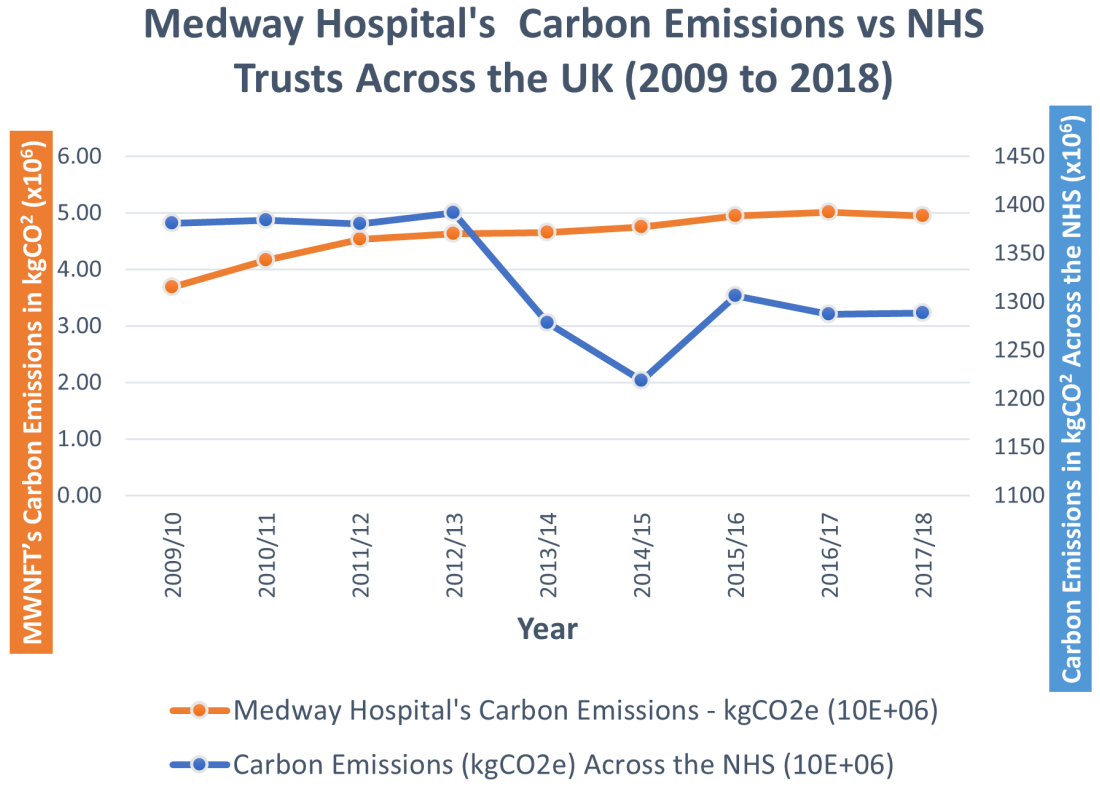
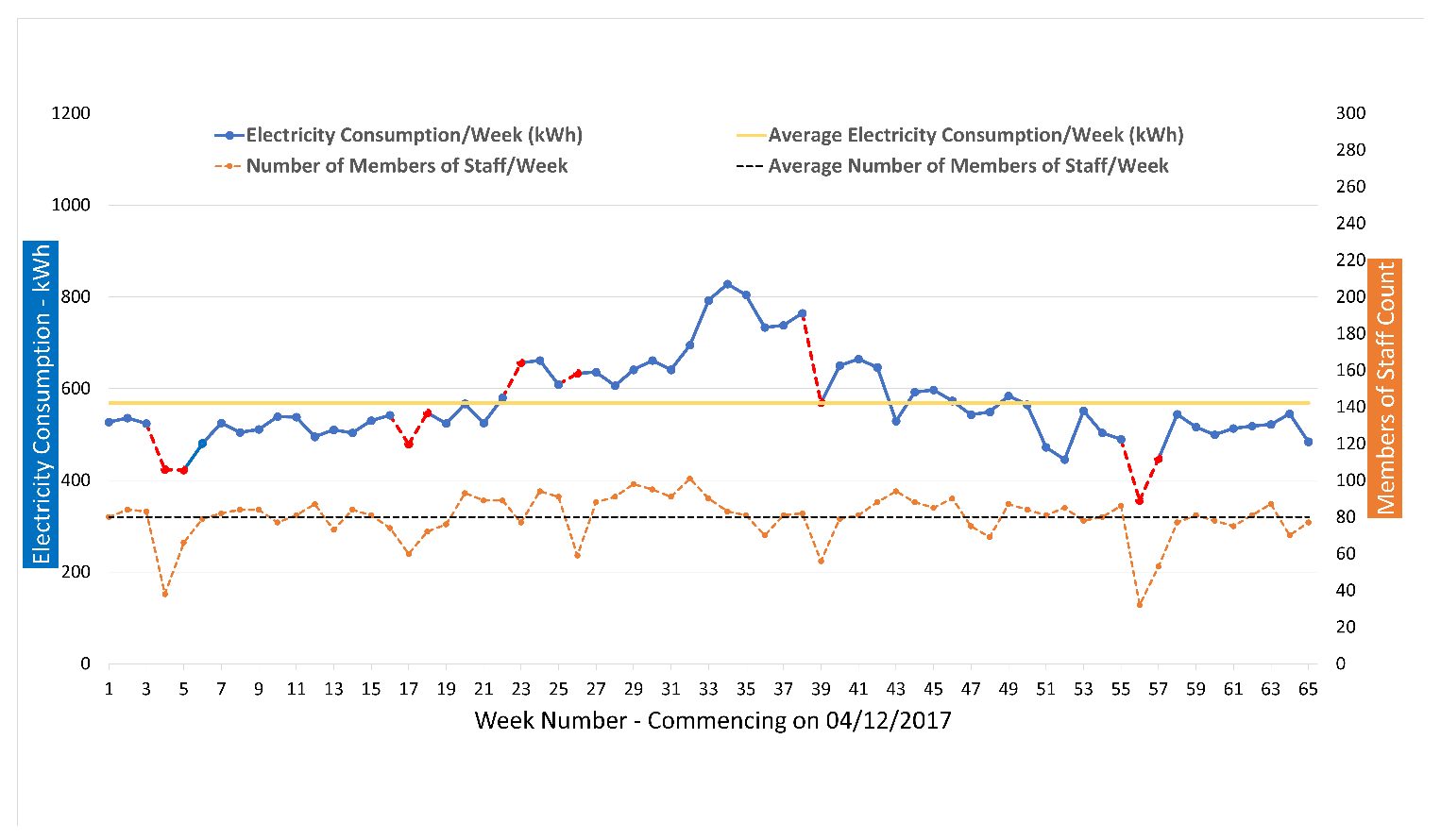
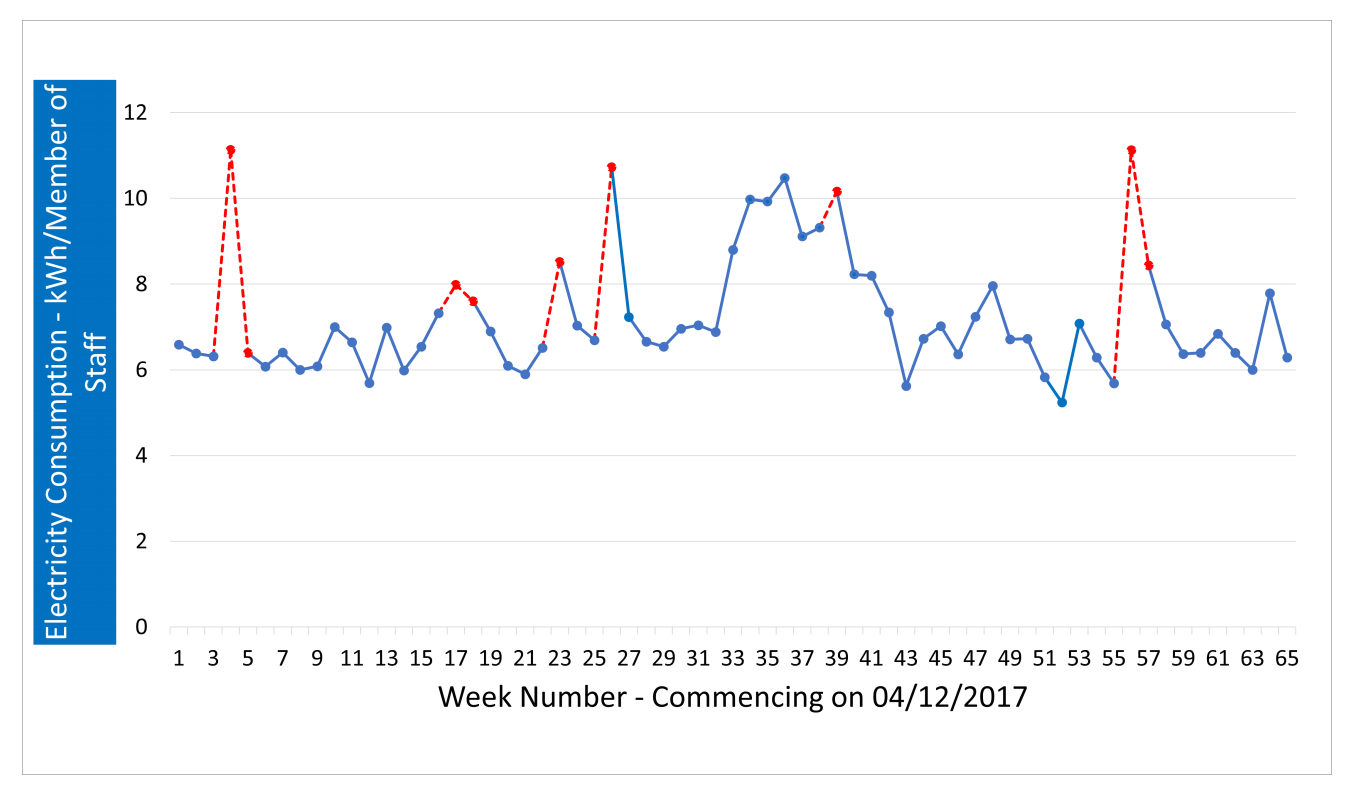
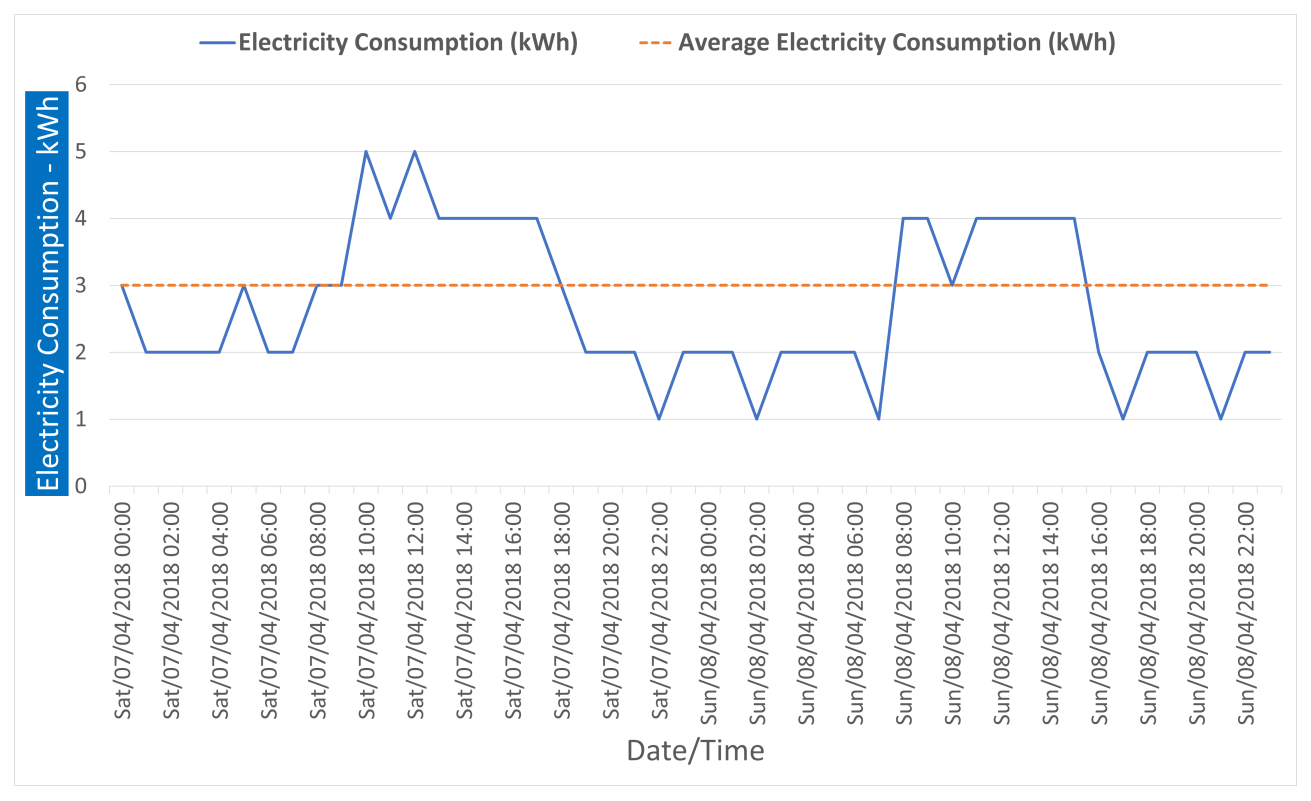
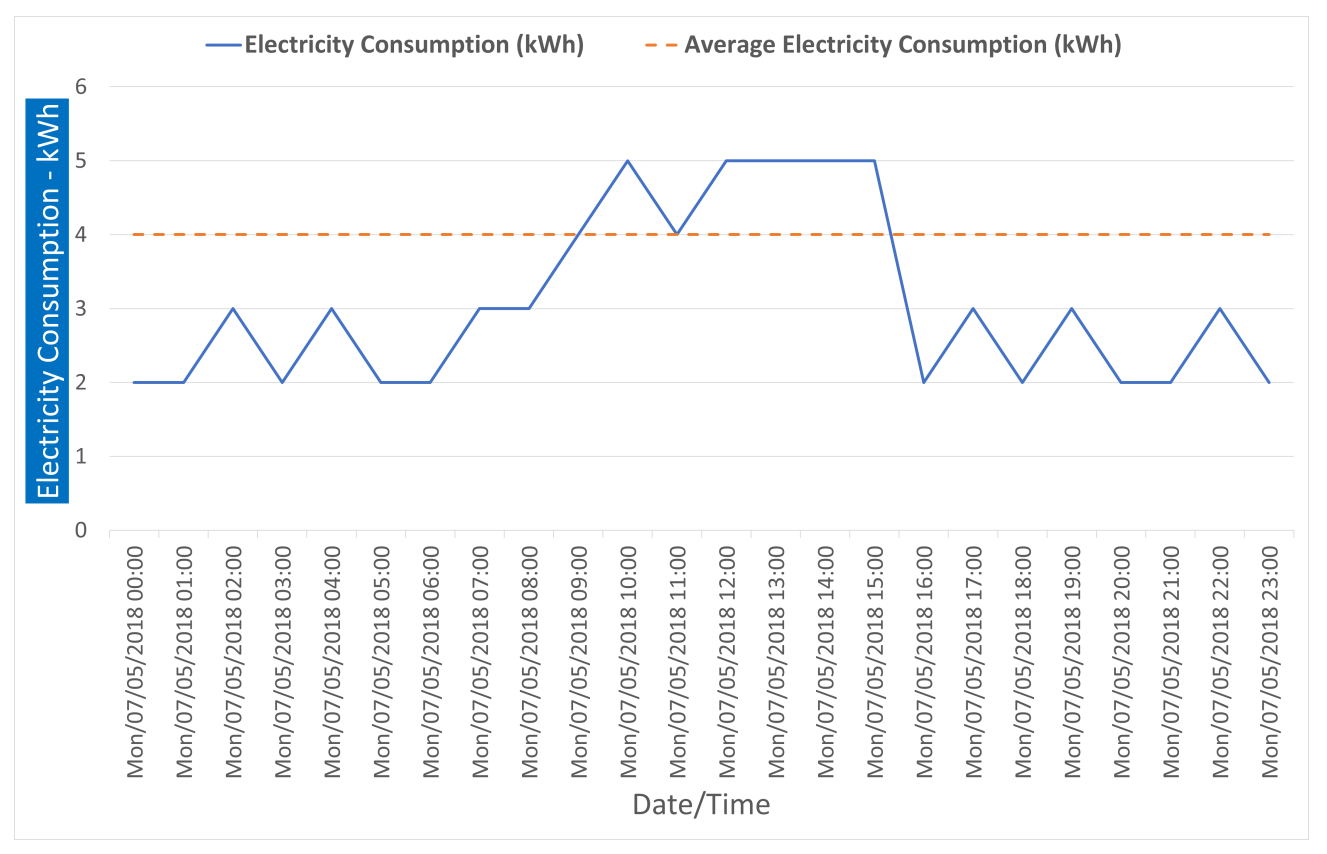
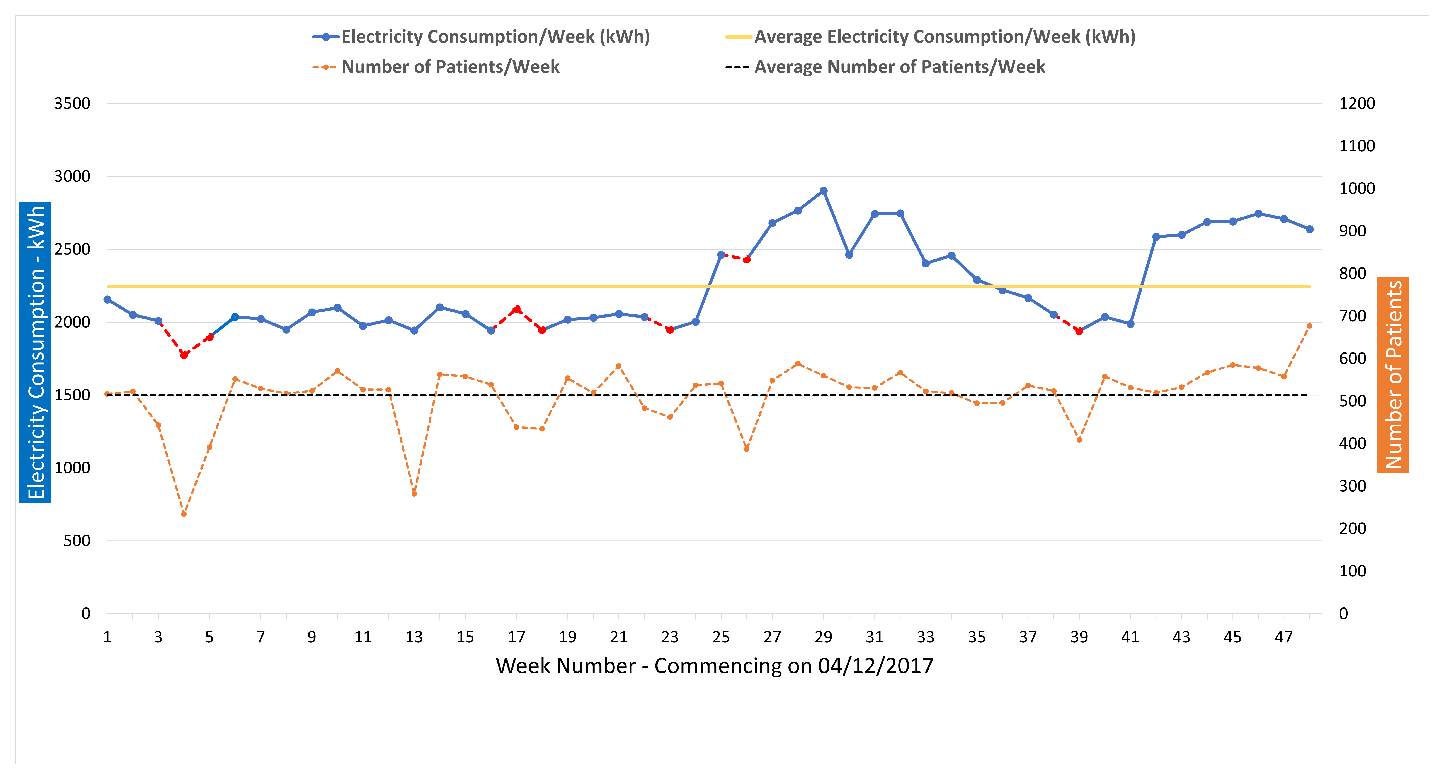
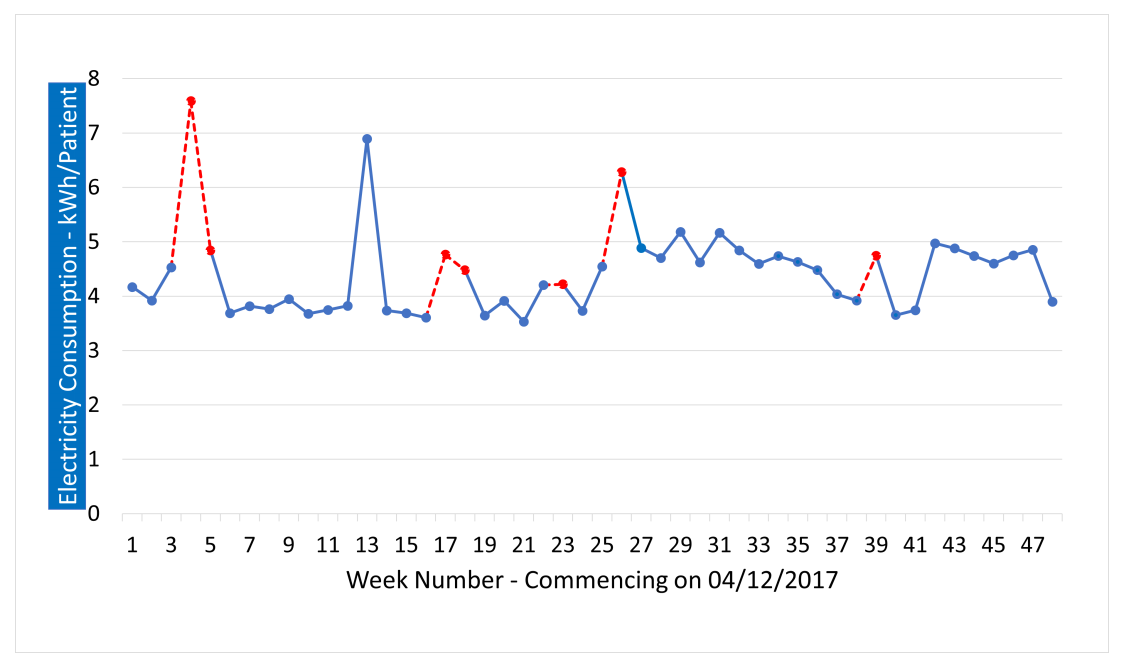
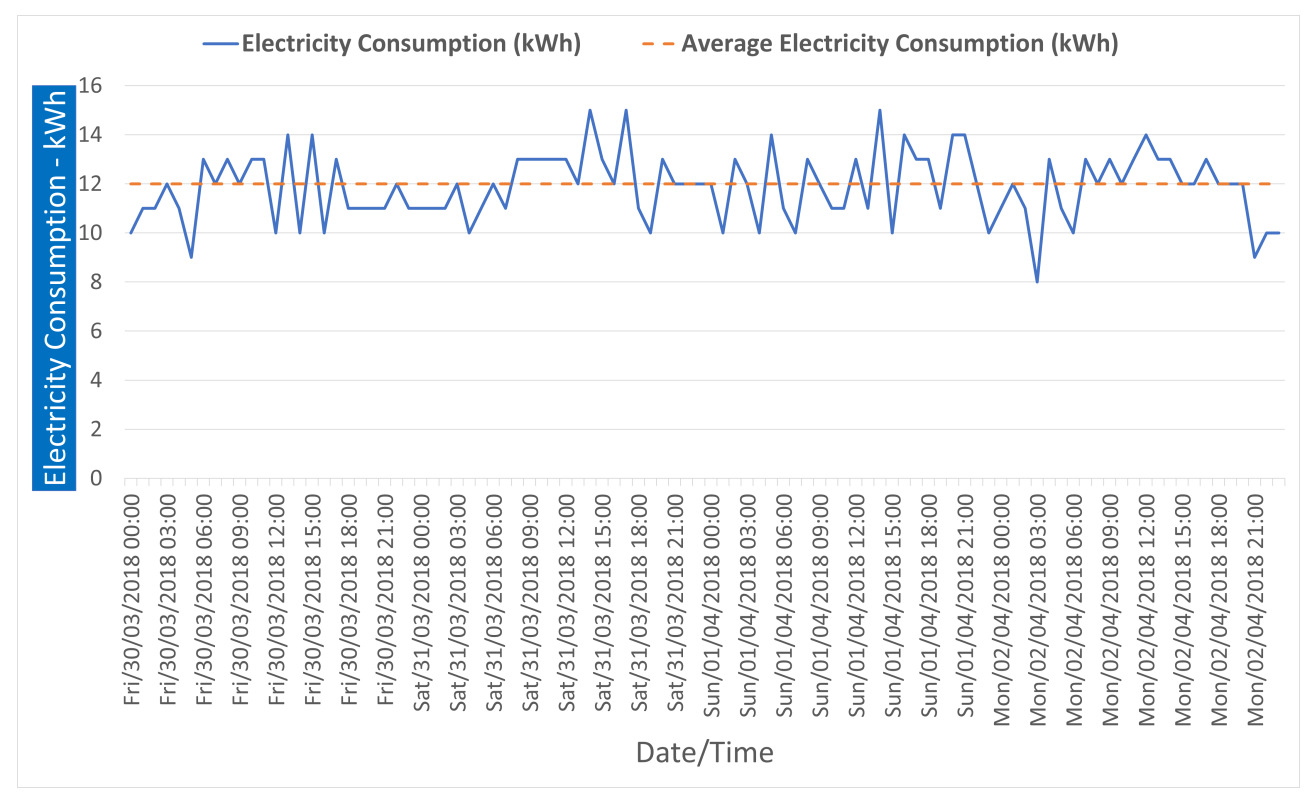
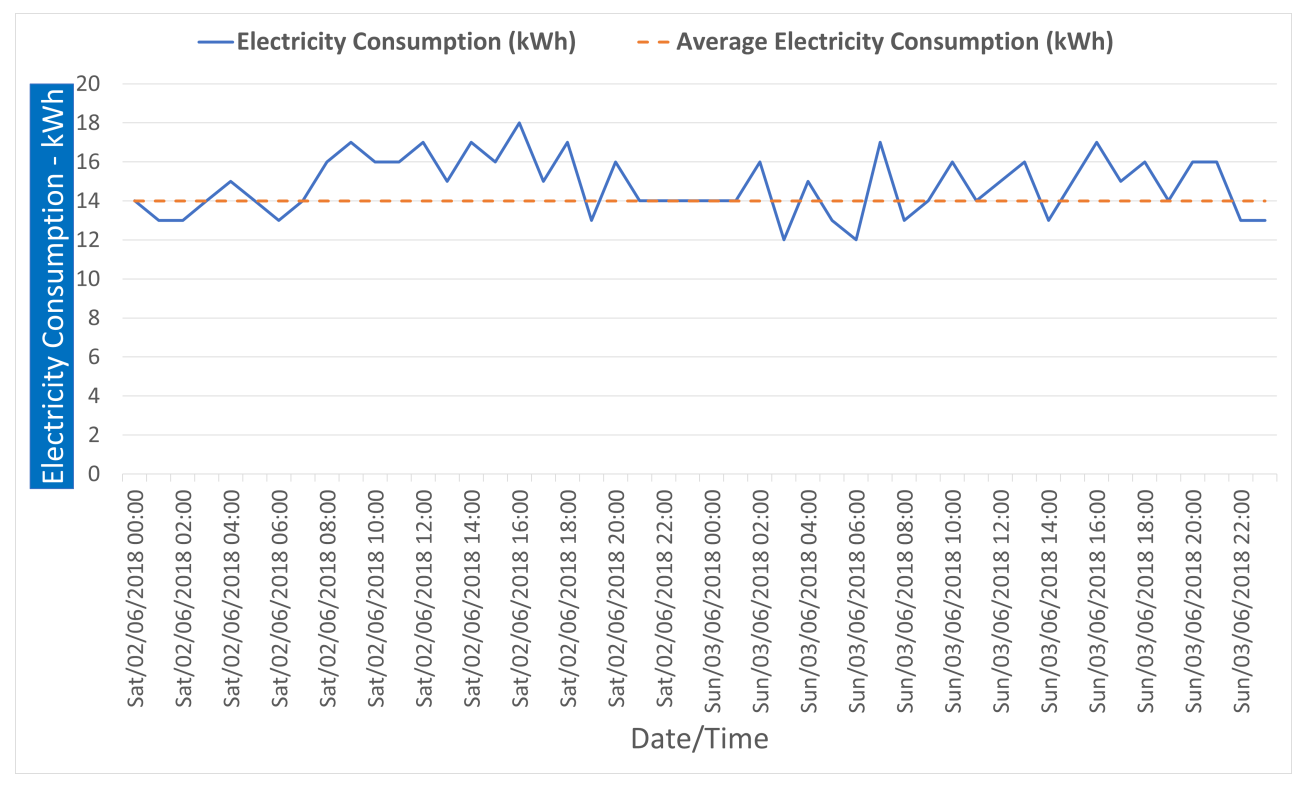
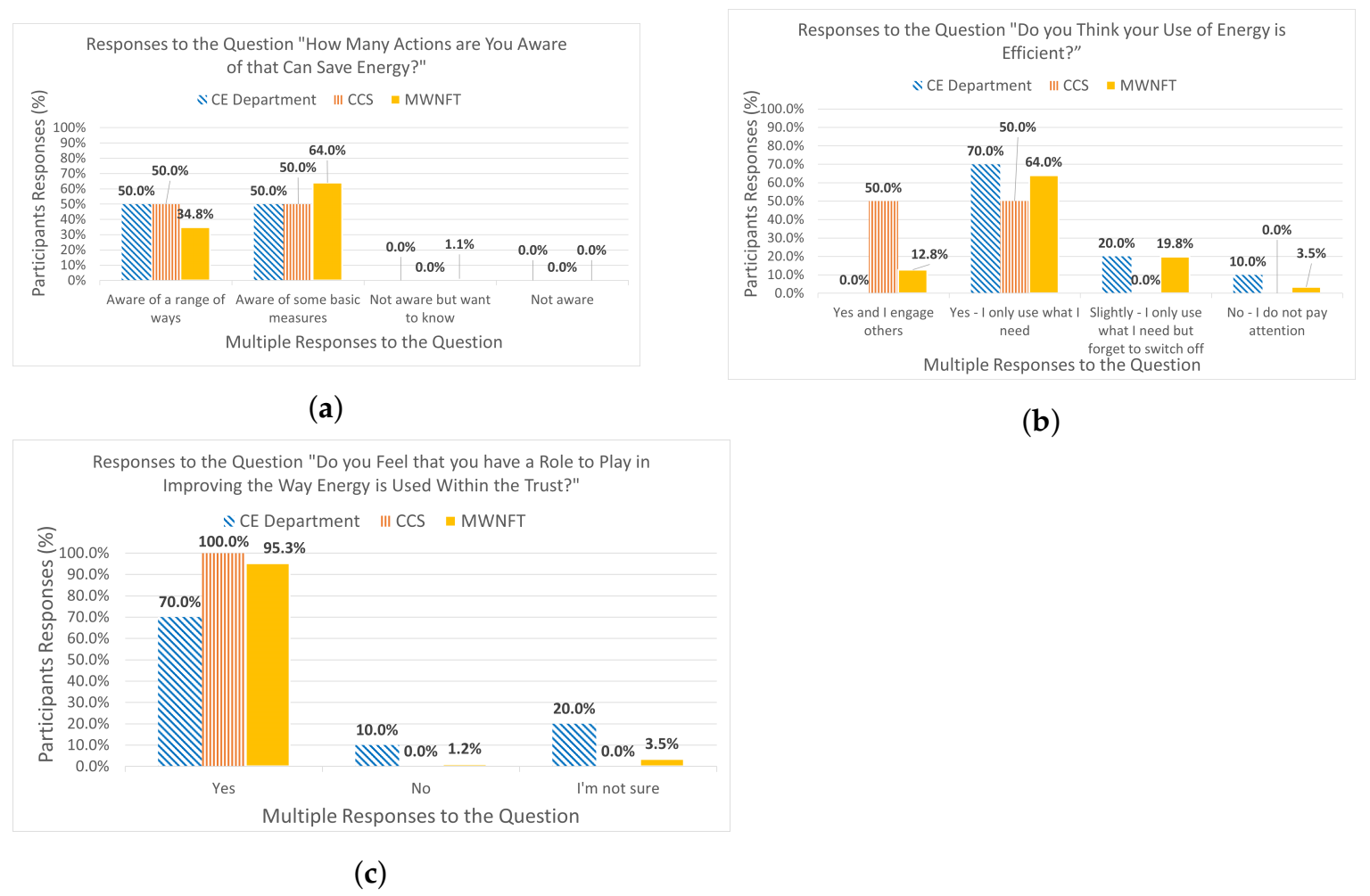
| Equipment | Dept. | Total Number in Each Area | % of Equipment Left on Out-of-Hours | Power Rating/Equipment (W) | Number of Hours Unused\Week | Out-of-Hours Consumption/Week (kWh) | Total Consumption/Week (kWh) |
|---|---|---|---|---|---|---|---|
| PC | CE | 20 | 60 | 18.8 | 103 | 23.24 | 38.73 |
| CCS | 12 | 90 | 20.91 | 23.24 | |||
| Monitor | CE | 31 | 70 | 0.6 | 103 | 1.34 | 1.92 |
| CCS | 21 | 90 | 1.17 | 1.30 | |||
| Laptop | CE | 4 | 80 | 45 | 103 | 14.83 | 18.54 |
| CCS | 0 | 0 | 0.00 | 0.00 | |||
| Printer | CE | 0 | 0 | 8 | 103 | 0.00 | 0.00 |
| CCS | 2 | 100 | 1.65 | 1.65 | |||
| Wall Mount Boiler | CE | 1 | 100 | 1.3 kWh/24 h | 103 | 17.00 | 17.00 |
| CCS | 1 | 100 | 17.00 | 17.00 | |||
| Screen | CE | 1 | 100 | 80 | 103 | 8.24 | 8.24 |
| CCS | 1 | 100 | 8.24 | 8.24 | |||
| Medical Equipment | CE | 0 | 0 | 10 | 103 | 0.00 | 0.00 |
| CCS | 17 | 85 | 14.88 | 17.51 | |||
| Total | 128.5 | 153.36 |
Publisher’s Note: MDPI stays neutral with regard to jurisdictional claims in published maps and institutional affiliations. |
© 2021 by the authors. Licensee MDPI, Basel, Switzerland. This article is an open access article distributed under the terms and conditions of the Creative Commons Attribution (CC BY) license (https://creativecommons.org/licenses/by/4.0/).
Share and Cite
Taha, A.; Hopthrow, T.; Wu, R.; Adams, N.; Brown, J.; Zoha, A.; Abbasi, Q.H.; Imran, M.A.; Krabicka, J. Identifying the Lack of Energy-Conscious Behaviour in Clinical and Non-Clinical Settings: An NHS Case Study. Electronics 2021, 10, 2468. https://doi.org/10.3390/electronics10202468
Taha A, Hopthrow T, Wu R, Adams N, Brown J, Zoha A, Abbasi QH, Imran MA, Krabicka J. Identifying the Lack of Energy-Conscious Behaviour in Clinical and Non-Clinical Settings: An NHS Case Study. Electronics. 2021; 10(20):2468. https://doi.org/10.3390/electronics10202468
Chicago/Turabian StyleTaha, Ahmad, Tim Hopthrow, Ruiheng Wu, Neil Adams, Jessica Brown, Ahmed Zoha, Qammer H. Abbasi, Muhammad Ali Imran, and Jan Krabicka. 2021. "Identifying the Lack of Energy-Conscious Behaviour in Clinical and Non-Clinical Settings: An NHS Case Study" Electronics 10, no. 20: 2468. https://doi.org/10.3390/electronics10202468
APA StyleTaha, A., Hopthrow, T., Wu, R., Adams, N., Brown, J., Zoha, A., Abbasi, Q. H., Imran, M. A., & Krabicka, J. (2021). Identifying the Lack of Energy-Conscious Behaviour in Clinical and Non-Clinical Settings: An NHS Case Study. Electronics, 10(20), 2468. https://doi.org/10.3390/electronics10202468









